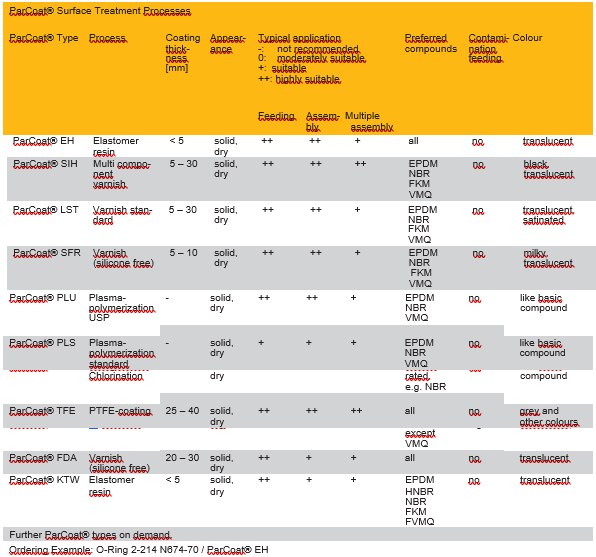As a manufacturer of precision seals, we have many years of experience
We, therefore, can work to complex customer-spe- cific requirements. At this time our customers for these products come from many branches of industry like Automobile, electronicss, measurement and control, aircraft, pneumatic, food and drug, just to mention but a few.
Our offer of assistance helps customers to reduce their costs from the planning stage to bulk production of moulded shapes. In matters of design, our application engineers cooperate with you to reduce production costs and review your problem in light of their experience.
Wide range of compounds
When a design is finalized the working lifetimes of such moulded shapes are decided upon the type of elastomer being selected. This decision can be taken only after detailed consultation where the application and all external influences which may affect the physical-chemical properties of an elastomer have been consideredd. The wide range of elastomers in the Parker line ensures optimum suitability for a given application because we know the advantages and limits of our elastomers. Therefore we are in a position to offer you an optimum solution.
Lubricant or grease is used with all types of O-ring seals to
Without a doubt, the greatest advantage of O-ring lubrication is the ease of assembly. Both the force required during assembly and the risk of damage by twisting will decrease. Improperly assembledd O-rings can lead to machine failure (see Section 10. Assembly hints).
The use of lubricant is particularly important in dynamic pneumaticc applications.
A lubricant should meet the following requirements:
The lubricant (and its additives) should not cause an elastomerr to swell or shrink.
The lubricant properties must remain constant over the whole working temperature range. This means that the lubricant should not flow like a liquid at high temperatures nor become solid at low temperatures.
The lubricant must be stable with no free constituents which might gather on the running surface.
The lubricant should have adhesive properties to ensure that the lubricating film is not removed by the O-ring.
Compatibility with the contact medium.
The lubricant should not block system filters.
Parker offers two lubricants covering together a wide range of applications: Parker O-Lube and Parker Super-O-Lube.
Parker O-Lube is a mineral oil-based lubricant containing barium soap. It eases assembly problems and contributes to a longer seal working life. The best results are obtained when both the seal and the running surface are treated with the grease. Parker-O-Lube has good resistance to water, adheres well to surfaces and offers good lubricating properties. It is particularly suitable for low-pressure applications with slow dynamic reciprocating, oscillating or rotating motion. Parker-O-Lube is not recommended for systems with micro-fil- terms or for seals which are not compatible with mineral oils (e.g. butyl, ethylene-propylene). Parker O-Lube is available in 110 g tubes and 16 kg buckets Processing to tight tolerances moulds are manufactured to the tightest tolerances in our tool room to the knowledge-based on years of experience. The selection of the production process, therefore, can be based on technical and economic factors allowing for greater flexibility and efficiency.
Quality
Quality assurance begins with research and development and ends with packing and dispatch inspection. Parker has built seven important quality control stations in its system to guaranteee quality, namely:
Only when a product passes the above inspection procedures can the Parker quality be attained.
.png)
Technical data
Content: appr 80 % mineral oil appr. 20 barium stearate
max 0.2 % water Stock point: -4 °C
Flame point: +224 °C
Recommended temperature range: -30 °C to +120 °C
Parker Super-O-Lube is a silicone-based lubricant and completess the range compatible with all elastomers (silicone compoundss have to be handled carefully; apply only a minimum quantity of Super-O-Lube). This lubricant is noted for its adhesivee properties, adhering well to both metal and rubber parts. It exhibits an unusually wide temperature range.
A thin layer of Parker Super-O-Lube protects certain elastomers from ageing. Unsaturated compounds, e.g. NBR, are particularly sensitive to ozone cracking unless they are protected with a fine film of grease. Super-O-Lube offers the best results when applied as a thin film and being neutral if does not react with a contact medium. Super-O-Lube is equally suitable for high pressure and vacuum applications; it is non-toxic and does not jam systems with micro- filters (to 30 µm). Parker Super-O-Lube is available in a 55 g tube and 3,6 kg or 18 kg buckets.
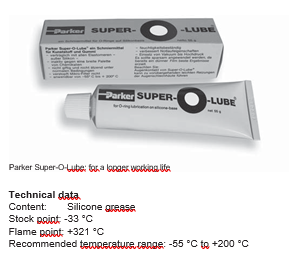
The great O-ring hunt draws to an end with an O-ring kit from Parker. Ideal for repair, fitting and assembly workshops. Available in various versions: customised repair kits consisting of a wide range of standard metric or imperial sizes in selected compounds. Optimum use of O-rings is assured because the kit is made to your immediate requirements.
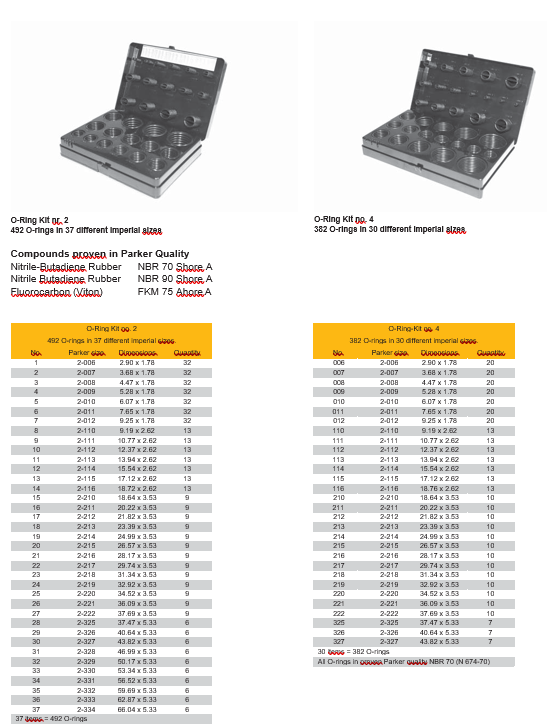

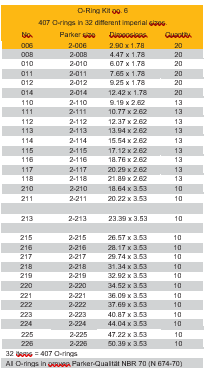
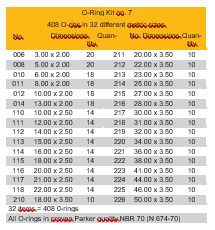
Further Kits for MS 33656 (Tube Fitting Boss Seals) are available in the compound N552-90 (Kit no. 8), as well as according to the Japanese metric standard JIS B 2401 in compound N674-70 (Kit no. 5)

The measuring cone can be used for quick and accurate defini- option of 2-xxx O-ring sizes up to 75 mm in diameter. The reference diameter of the cross-section is easily noted using the calibrated slot in the cone base.
Cone, e.g. cross-section 2.62 mm is the 2-1xx series. The 2-1xx series is read from the cone directly above the calibrationn slot for the 2.62 mm section. The respective inner diameter in millimetres then can be taken from the size list. The measuring tape suits O-ring diameters up to 200 mm and is used in a similar way like the cone. The different scales on the tape apply to diverse cross-sections.
These tools make O-ring assembly and removal much easier in avoiding damage. The kit including two pieces is delivered completee in a plastic wallet.

ParCoat®-treated O-rings enable frictionless automatic assemblyy with only minimal exertion of force. During the feeding process, the rings will not stick together. Before installation, they can be elongated by more than 150 %, dependingg on the type, without causing the anti-friction coating to break or tear.
Fitting components with uncoated O-rings, and the other hand, often requires assembly pressures to be exerted that are twice as high as those needed for ParCoat®-treated seals. Such high pressures may result in seal damage and jamming of assembly components. Conventional surface treatment and coating techniques, such as oiling, improve the sliding ability of the seals only insufficiently while soiling the assembly components. Defects during the assembly process lead to additional costs for inspections and rework which exceed the relatively small extra charge for ParCoat®-treated O-rings.
Parker’s developed ParCoat® EH (standard) solution is a polymer film of merely a few micrometres of thickness with outstand- ing sliding properties that are applied to the seal without degrading the elasticity of the basic compound.
Depending on the contact medium, the coating may disintegrate into tiny particles sometime after assembly. This disintegration will neither contaminate the medium nor lead to any malfunction. Exposure trials involving three different test media, followed by a subsequent particle count, have confirmed that there is no difference between the media before and after exposure to ParCoat®.
Benefits
Furthermore, the coating is transparent, enabling the elastomers to be identified by their specific colours, thus precluding the risk of mix-ups.
Typical areas of application are first, automatic and multiple assembly processes. Due to its minimal thickness, e. g. ParCoat® EH is not suitable for achieving permanent improvements of slid- ing ability in dynamic sealing applications. ParCoat® surface treatment has been integrated into regular manufacturing processes, thus ensuring full-scale in-process controls, flexibility and short lead times. Parker produces coated O-rings from nearly all standard compounds.
Application examples Automotive engineering
Air-conditioning lines Fuel system quick couplings Sensors, electrical connections Industrial applications Instrumentation, fittings, fixtures Plug connectors Meters Fittings.
